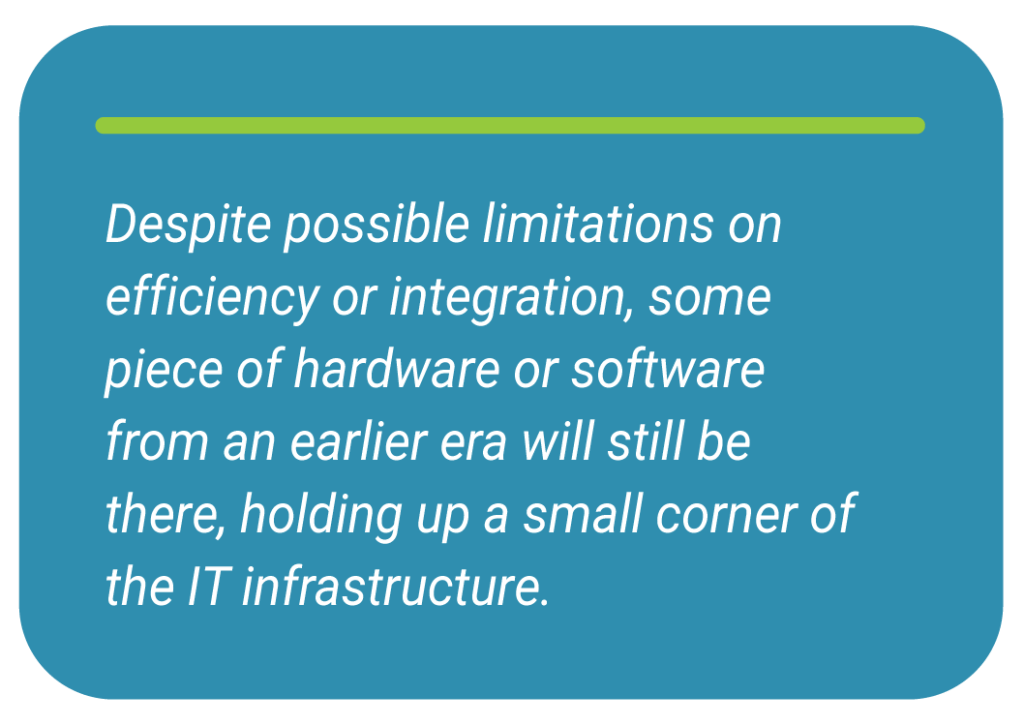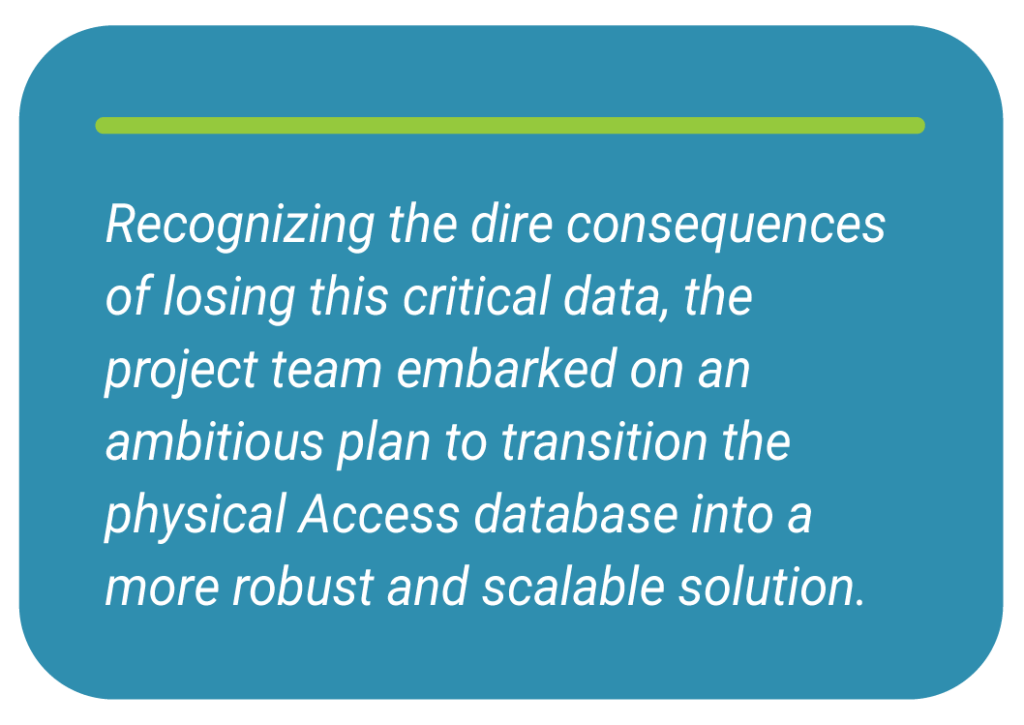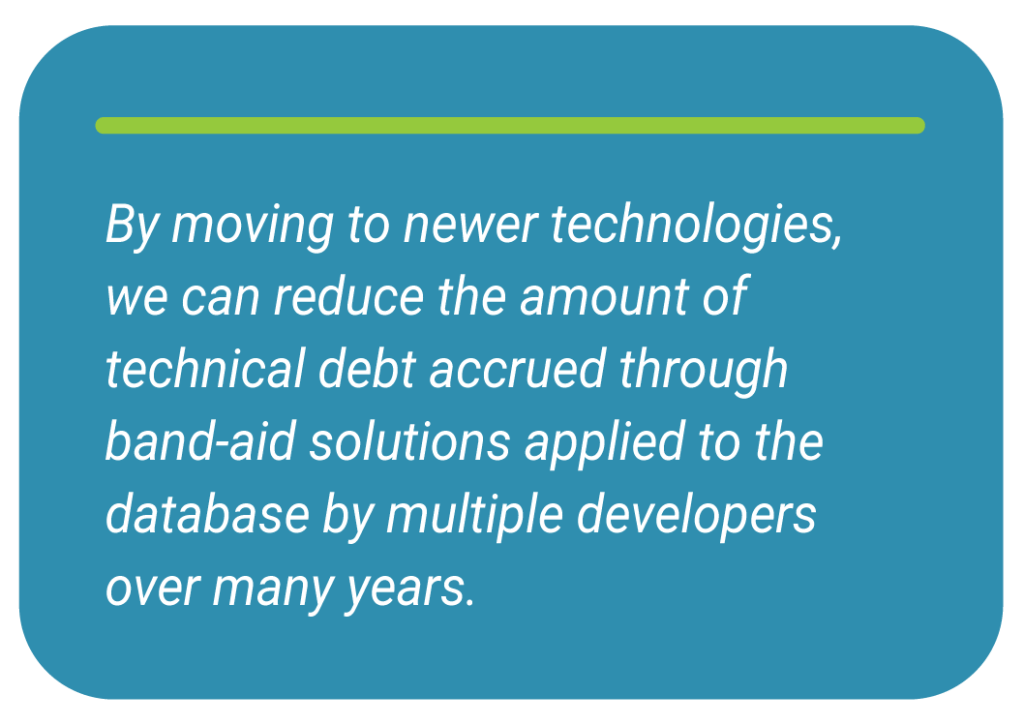The Spark

Innovating Beyond Boundaries

Upgrading Legacy Technology for Security and Integrity: A Case Study
By K.R. “Mitch” Mitchell, Noblis
 If you drill down far enough into the enterprise architecture of any agency, or any company for that matter, you are likely to find at least one surprising element of legacy technology hanging on, doing its job out of sight. Despite possible limitations on efficiency or integration, some piece of hardware or software from an earlier era will still be there, holding up a small corner of the IT infrastructure. It’s understandable, after all, since agencies rarely do a top-to-bottom technology refresh, and a system that is doing a good-enough job might get overlooked in several generations of piecemeal upgrades.
If you drill down far enough into the enterprise architecture of any agency, or any company for that matter, you are likely to find at least one surprising element of legacy technology hanging on, doing its job out of sight. Despite possible limitations on efficiency or integration, some piece of hardware or software from an earlier era will still be there, holding up a small corner of the IT infrastructure. It’s understandable, after all, since agencies rarely do a top-to-bottom technology refresh, and a system that is doing a good-enough job might get overlooked in several generations of piecemeal upgrades.
These technology orphans, however, can present vulnerabilities to overall cybersecurity, process efficiency or data integrity. Even when these weak points are identified, it’s not always easy to transition them to work within modernized systems. But it is essential to the overall architecture to integrate them as quickly and securely as possible.
Recently, Noblis helped a federal customer address such a challenge. The agency was storing key assessment data on a homegrown database that was developed using Microsoft Access. Initially conceived as a straightforward tool to organize evaluation data, this Access database quickly evolved into the central repository.
The database was originally developed on a local machine by a team who saw the need for a more structured way to manage their data. But as the program expanded, so did the database’s role, morphing from a simple data organizer into the backbone of the infrastructure. Over time, it grew in complexity and size, storing an ever-increasing volume of data that continued to multiply.
Unfortunately, this rapid growth came at a cost. The once-nimble Access database ballooned into an unwieldy behemoth. Its size and complexity began to outstrip the capabilities of the Access platform, placing it on the verge of crashing. The project team faced constant challenges, applying band-aid fixes and devising workarounds to prevent system failures. Despite the team’s best efforts, the risk of a catastrophic crash loomed large, threatening to obliterate twelve years’ worth of invaluable evaluation data.
The Noblis Solution
 Recognizing the dire consequences of losing this critical data, the project team embarked on an ambitious plan to transition the physical Access database into a more robust and scalable solution. They identified SQL databases within the AWS cloud as the ideal platform for this migration. This move would not only safeguard the existing data but also provide a more stable and efficient environment for future growth.
Recognizing the dire consequences of losing this critical data, the project team embarked on an ambitious plan to transition the physical Access database into a more robust and scalable solution. They identified SQL databases within the AWS cloud as the ideal platform for this migration. This move would not only safeguard the existing data but also provide a more stable and efficient environment for future growth.
The team’s goal was clear: to ensure the continuity and integrity of the data by migrating the database to the cloud. This solution would eliminate the imminent risk of data loss and provide a solid foundation for the program’s ongoing and future needs. Through diligent planning and execution, the project team aimed to transform the fragile, overburdened Access database into a secure, scalable and reliable SQL database in the cloud.
One of the largest technical challenges during this process was creating clear documentation and communication between relevant stakeholders. Because this database had become integral to every part of the program’s functions, there were many requirements that needed to be preserved when transitioning to a new platform. However, since users may not necessarily have the time or expertise to communicate the details of these requirements to development teams, the project team had to document the users’ needs in a structured manner.
The transition to a SQL server will result in multiple benefits for the database. As mentioned, the primary concern had been the stability of the database. Microsoft SQL Server has automatic backup and rollback features that protect the database from accidental corruption or deletion. A SQL database is also more efficient, allowing for faster data processing as the database grows larger over time.
The Long-term Impact
 Aside from these technical benefits, there are additional organizational benefits to this transition. Currently, all data utilized by the database is input by users, which includes data copied from other existing databases within the customer organization. By moving the database to the cloud, the team will be able to connect to these authoritative data sources, reducing manual effort and potential for human error, while also reducing data storage requirements of storing duplicate data.
Aside from these technical benefits, there are additional organizational benefits to this transition. Currently, all data utilized by the database is input by users, which includes data copied from other existing databases within the customer organization. By moving the database to the cloud, the team will be able to connect to these authoritative data sources, reducing manual effort and potential for human error, while also reducing data storage requirements of storing duplicate data.
A more subtle benefit is the long-term developmental benefits from moving to a SQL server. By moving to newer technologies, we can reduce the amount of technical debt accrued through band-aid solutions applied to the database by multiple developers over many years. Working with a SQL database is a more common skill in the workforce and will make it easier to apply cleaner solutions now as well as in the future.
Modernizing legacy systems within federal agencies and other organizations is critically important. While the initial investment may seem daunting, the long-term benefits far outweigh the costs. In fact, agencies can achieve significant cost savings over time by reducing the need for continuing maintenance and workarounds on outdated systems. Moreover, the enhanced data security provided by modern platforms like SQL, with built-in backup and rollback features, safeguards invaluable information against loss or corruption. The ability to integrate with authoritative data sources also streamlines operations, reduces manual errors and encourages more efficient use of resources.
Ultimately, the migration to modern technology is not just a technical upgrade; it is a strategic move that strengthens the overall architecture, ensuring that agencies are better equipped to meet their missions with stability, security and scalability.
How can we help your agency?
Contact UsContact Noblis to learn more about putting our advanced capabilities and technologies to work for your agency.More Content to Explore





